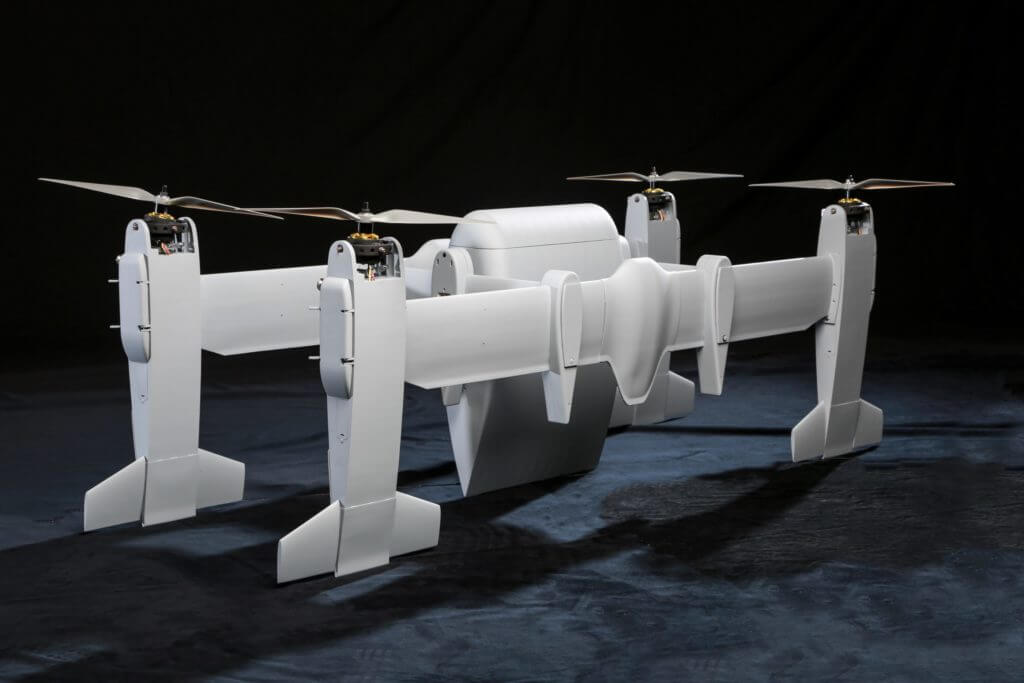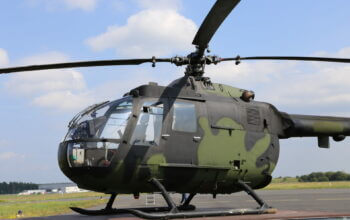Bell hopes to complete the first flight of a multicopter unmanned aerial vehicle (UAV) it is developing for cargo transport this week.
Targeting both military and civilian third-party logistics applications, Bell is currently developing the technology, known as Autonomous Pod Transport (or APT), in two sizes: the APT 20 (which can carry up to 20-pound/nine-kilogram loads), and the APT 70 (which can transport loads weighing up to 70 pounds (32 kilograms).

Bell has already begun flying the smaller APT 20, and hopes to take the APT 70 to the skies in the next few days.
The technology is designed to be scalable, with the aircraft utilizing the same simple design — a gimballed four-bladed rotor at each end of two biplane-style wings, with a cargo pod sitting on brackets between the two wings.
Underneath each rotor is a “vector thrust module” that contains all the high-powered electronics behind the propulsion system — batteries, speed controllers, the motor and servo. A fully-integrated avionics and sensor suite is embedded in the airframe.
The APT 20 spans about three feet by five feet, is capable of speeds up to 100 knots, and has a range of about 11 miles (18 kilometers).
The APT 70 has a six- by nine-foot footprint, can travel up to 120 knots, with a range of 19 miles (30 kilometers).
Beyond these two models, Bell is looking at scaling the aircraft up to carry loads of up to 1,000 pounds (450 kilograms).
The aircraft are designed to be fully autonomous, taking off vertically before rotating 90 degrees on the pitch axis to transition to forward flight, then flying along waypoints on a predetermined route. It transitions back to vertical flight for its landing.
“The big driver for us to be interested in this market is that the third-party logistics market shows a lot of growth,” said John Wittmaak, innovation manager at Bell. “By 2020 it’s nearing $1 trillion. . . So the market is continuing to grow — there’s a lot of potential there.”
Through a systems integration and operationalism (SIO) contract it won from NASA, Bell will be using the APT 70 to conduct demonstrations beyond visual line of sight with detect and avoid capability, in and out of controlled airspace. The demonstrations will begin in the first half of 2020.
“It’ll be a technology demonstration, not necessarily a fully certified product,” said Wittmaak. “But it’s a stepping stone with the FAA [Federal Aviation Administration] and NASA to understand what the . . . technologies will really look like on aircraft of this scale.”
Bell has also launched a collaboration with Japanese third-party logistics provider Yamato to demonstrate APT’s capabilities and understand how customers will interface with it. “It’s very exploratory,” said Wittmaak. “We’re developing requirements and we’re doing collaborative design.”
The manufacturer will continue flight tests of the APT 20 and APT 70 throughout 2019 under its own experimental type certificate to test the sensors on the aircraft. “[It’s] all the testing necessary to convince the FAA that our ops are safe, our systems are doing what they’re supposed to be, so that we can bring it into an urban environment and do that [safely],” said Wittmaak.
The main interest in the APT 20 has been on the military side, he added, with its potential to deliver small supplies and shipments out to deployed units particularly appealing. The modularity of the system also offers clear benefits, he said, with the aircraft capable of being assembled or disassembled using simple tools in a matter of minutes.









